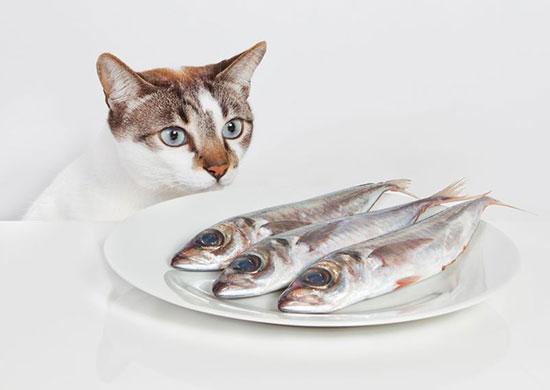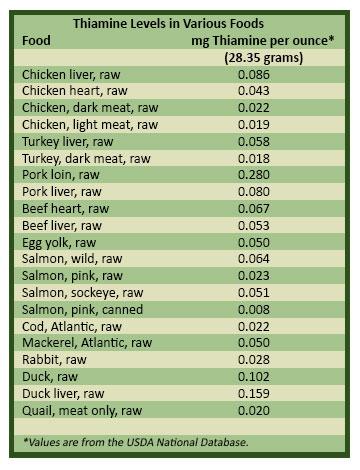This content is archived from the Feline Nutrition Foundation
Thiamine in Raw Food for Cats
- Updated: Sunday, June 02, 2019 02:34 PM
- Published: Saturday, April 19, 2014 05:21 PM
- Written by Elisa Katz, DVM
 There have been recent recalls of thiamine-deficient canned cat food. Is a raw cat food diet safe from being deficient since it's not cooked?
There have been recent recalls of thiamine-deficient canned cat food. Is a raw cat food diet safe from being deficient since it's not cooked?
In the past five years, there have been many recalls of commercial pet foods for various reasons. Five of these recalls have been related to the diets being deficient in thiamine, also known as vitamin B1. At least three of these recalls involved canned food.¹ None of these has been a raw commercial diet.
Thiamine is a water-soluble B vitamin important for helping the body to utilize carbohydrates as energy through a process called the TCA cycle. It is a necessary cofactor involved in this energy producing-process. It is especially important for healthy functioning of the nervous system and heart. Deficiency of thiamine can cause neurologic signs, abnormal heartbeats and gastrointestinal signs.² Thiamine is naturally found in various food sources, some of which include whole grains and vegetables, legumes and brewer's yeast. But, it is also present in muscle tissue of animals, particularly in the liver and heart. The mere presence of thiamine in a food may not correlate with its activity or bioavailability. Several factors may affect the bioavailability and/or activity of it in processed foods. As much as 50% to 100% of the thiamine present in raw meat can be inactivated by one or more of the following processing methods: heat, high amounts of sulfur based food preservatives, i.e. sulfur dioxide, and certain thickening additives in canned foods which may alter the pH of the food.³
 Raw cat food is not exposed to heat as canned and dry diets are. Therefore, the thiamine in these diets remains intact. Also, they do not use any of the additives or preservatives found in canned foods.
Raw cat food is not exposed to heat as canned and dry diets are. Therefore, the thiamine in these diets remains intact. Also, they do not use any of the additives or preservatives found in canned foods.
As obligate carnivores, cats are unable to produce adequate amounts of thiamine and therefore need to consistently consume it in their diet. Cats require three times as much of it in their diet as dogs.⁴ The recommended daily allowance of thiamine per day for cats is 0.33 mg. Note that this is for an approximately 250 kilocalorie diet, which is about what a nine-pound cat would eat per day.⁵ A cat will typically eat about four to five ounces of meat per day. As you can see from the chart, you can easily meet the minimum RDA for thiamine by feeding a variety of meats and including heart and liver. Plus, you can be certain that the thiamine in this diet has not been inactivated by processing. Many commercial raw cat food meals either contain significant amounts of liver and heart or may have added nutrient supplements.
There are certain species of fish and shellfish that contain an enzyme called thiaminase which inactivates thiamine. However, the species known to contain this enzyme are generally not used in any of the commercial raw meals. Most of the fish in these commercial products is either salmon or cod, which do not contain thiaminase.⁶ For a complete list of fish and shellfish that do and do not contain thiaminase you can turn to this website.
Raw cat food diets also have little to no carbohydrate content. This type of food requires less thiamine because there is little to no need for carbohydrate metabolism and therefore much less requirement for the enzyme involved in the TCA cycle. High-carbohydrate diets such as most dry and canned cat foods require more thiamine as it will need to be used in large amounts in an attempt to metabolize the carbohydrates.⁷
Additional Reading
Adding Taurine to a Raw Cat Food Diet
The bottom line is that raw cat foods are safe when fed properly, either by using a commercially-prepared and balanced meal or by diligently making sure to take the steps to balance a homemade diet, either through use of individual supplements or prepared pre-mixes intended for use with raw meat.
I encourage anyone considering raw food for cats to take the plunge. You will see some amazing changes in your kitty with proper cat nutrition.
Note: Feline Nutrition provides feline health and nutrition information as a public service. Diagnosis and treatment of specific conditions should always be in consultation with your own veterinarian. Feline Nutrition disclaims all warranties and liability related to the veterinary advice and information provided on this site.
Dr. Elisa Katz, DVM, is a graduate of Ohio State University and is the owner of Natural Pet Animal Hospital in Bourbonnais, Illinois. She practices holistic and integrative medicine focusing on proper diet and nutrition. Dr. Katz shares her home with four kitties and one dog.
1. US Department of Health and Human Services, FDA, Recalls and Withdrawals.
2. J Markovich, C Heinze and L Freeman, "Thiamine Deficiency in Dogs and Cats," Journal of the American Veterinary Medical Association, vol. 243, no. 5, Sept 1, 2013, 649-656.
3. Markovich et al, "Thiamine Deficiency in Dogs and Cats."
4. Markovich et al, "Thiamine Deficiency in Dogs and Cats."
5. "Your Cat's Nutritional Needs, A Science-Based Guide for Pet Owners," National Research Council of The National Academies.
6. M Lichtenberger, "Thiaminase and its Role in Predatory Pet Fish Nutrition," Wet Web Media. 2011.
7. J Markovich, C Heinze and L Freeman, "Thiamine Deficiency in Dogs and Cats," Journal of the American Veterinary Medical Association, vol. 243, no. 5, Sept 1, 2013, 649-656.
Data used in the chart derived from USDA Agricultural Research Service, USDA National Nutrient Database for Standard Reference.




